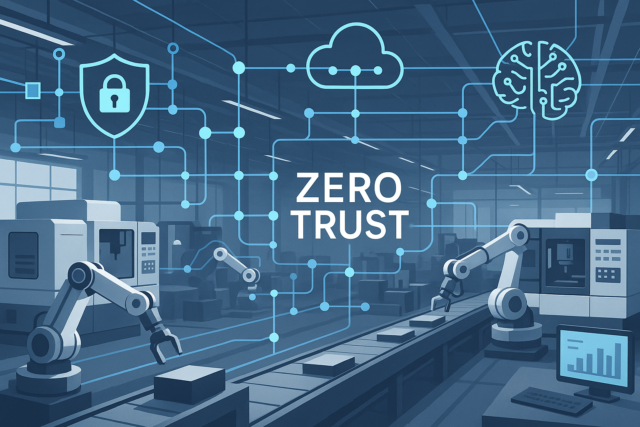In today’s manufacturing and enterprise environments, the old security adage of “trust but verify” is no longer enough. With the rapid adoption of cloud services, remote working, and the ever-increasing sophistication of cyber threats, IT managers are under pressure to rethink how their organisations approach network security. The answer for many is Zero Trust — a modern framework that’s transforming how businesses protect their data, users, and operations.
What is Zero Trust?
Zero Trust is more than just a buzzword; it’s a fundamental shift in security philosophy. Instead of assuming that everything inside your network can be trusted, Zero Trust operates on the principle of “never trust, always verify.” Every user, device, and application, inside or outside the traditional network perimeter, must prove its identity and legitimacy before being granted access.
This approach is particularly relevant as boundaries between office, home, and cloud environments blur. According to Gartner, more than 60% of organisations will use Zero Trust as the foundation for their security strategies by 2025.
Why Zero Trust is Essential for Modern Enterprises
The traditional castle-and-moat approach to security, where defences are focused on keeping threats out, simply doesn’t work in a world where employees, partners, and devices connect from everywhere. Attackers are increasingly adept at breaching perimeters, and once inside, they can move laterally with ease.
Zero Trust addresses this by:
-
Verifying every access request – regardless of where it originates.
-
Minimising the attack surface – through network segmentation and least-privilege access.
-
Continuously monitoring for threats – using behavioural analytics and real-time policy enforcement.
For IT managers, this means a significant reduction in risk, improved compliance, and greater confidence when enabling digital transformation initiatives.
Key Principles of Zero Trust
Implementing Zero Trust is about more than deploying new technology. It’s a strategic framework built on several core principles:
1. Identity as the New Perimeter
Every access request should be authenticated and authorised. Multi-factor authentication (MFA) and strong identity management are critical. As Microsoft notes, identity-driven security is the foundation of Zero Trust.
2. Least Privilege Everywhere
Users and devices should only have access to the resources they need. By limiting permissions and segmenting networks, you reduce the potential impact of a breach.
3. Micro-Segmentation
Breaking the network into smaller, isolated segments prevents attackers from moving freely if they do get in. This is especially important in manufacturing, where operational technology (OT) and IT often intersect.
4. Continuous Verification
Access isn’t granted once and forgotten. User behaviour, device health, and context are constantly evaluated. If something looks suspicious, access can be revoked immediately.
5. End-to-End Encryption
Data should be protected both in transit and at rest. Encryption ensures that even if data is intercepted, it remains unreadable.
For a deeper dive into these principles, the UK National Cyber Security Centre (NCSC) offers practical guidance on Zero Trust architectures.

The Business Benefits of Zero Trust
Zero Trust isn’t just about security — it’s about enabling the business. Here’s how:
-
Reduced breach risk: By verifying every access request and segmenting networks, you limit the damage attackers can do.
-
Improved compliance: Zero Trust frameworks make it easier to meet regulatory requirements by enforcing consistent policies and providing detailed audit trails.
-
Operational agility: With secure remote access and cloud integration, your organisation can innovate and adapt faster.
-
Enhanced user experience: Modern Zero Trust solutions use adaptive authentication, so legitimate users aren’t constantly interrupted while suspicious activity is quickly flagged.
The NSA and Microsoft both highlight how Zero Trust can reduce downtime and speed up recovery after incidents.
Zero Trust and SASE: A Powerful Partnership
Zero Trust is often implemented alongside Secure Access Service Edge (SASE), a cloud-based approach that combines networking and security functions. SASE simplifies management, unifies security policies, and provides secure access to applications wherever users are located.
For hybrid and distributed workforces, integrating Zero Trust with SASE delivers:
-
Unified policy management
-
Reduced network complexity
-
Consistent security across all access points
Learn more about this synergy from Gartner’s SASE overview.
Overcoming Common Zero Trust Challenges
Transitioning to Zero Trust isn’t without hurdles. IT managers often face:
-
Legacy system integration: Older applications may not support modern authentication or segmentation.
-
Resource constraints: Skilled security professionals are in short supply.
-
User resistance: Change can be disruptive, so clear communication and training are vital.
A phased approach works best: start with the most critical assets, build expertise, and expand Zero Trust incrementally. Consider working with a managed service provider like Digital Carbon to fill skill gaps and accelerate deployment.
The Role of Managed Services in Zero Trust
Partnering with a managed service provider like Digital Carbon can make Zero Trust adoption smoother and more effective. Here’s how:
-
Expertise on tap: Benefit from up-to-date knowledge and best practices.
-
24/7 monitoring: Rapid detection and response to threats.
-
Seamless integration: Connect Zero Trust with SD-WAN, SASE, and cloud environments.
-
Ongoing support: Training, policy updates, and continuous improvement.
Practical Steps for IT Managers
If you’re ready to embark on a Zero Trust journey, here’s a practical roadmap:
-
Assess your current environment: Identify users, devices, and applications that need protection.
-
Prioritise high-risk areas: Focus on critical data and systems first.
-
Implement strong identity controls: Deploy MFA and centralised identity management.
-
Segment your network: Use SD-WAN and micro-segmentation to limit lateral movement.
-
Monitor continuously: Use real-time analytics and threat detection.
-
Educate your users: Provide regular training and clear policies.
For implementation templates and maturity models, the NIST Zero Trust Architecture guide is an excellent resource.
Looking Ahead: Zero Trust as a Business Enabler
Zero Trust is not a one-time project — it’s an ongoing journey that adapts as your business evolves and threats change. The combination of Zero Trust, SD-WAN, and SASE offers a future-proof approach to security, enabling innovation while keeping your data and operations safe.
At Digital Carbon, we specialise in helping organisations like yours design, implement, and manage Zero Trust architectures that fit your unique needs. Whether you’re just starting out or looking to enhance your existing security posture, our team is here to support you every step of the way.
Ready to take the next step? Contact Digital Carbon for a consultation, or explore our resources to learn more about Zero Trust and co-managed network security.
Stay ahead of evolving threats—subscribe to our blog for more insights on SD-WAN, Zero Trust, and network security best practices for IT leaders in manufacturing and beyond.

